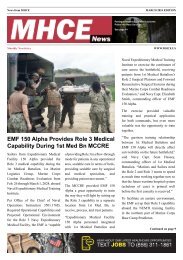You also want an ePaper? Increase the reach of your titles
YUMPU automatically turns print PDFs into web optimized ePapers that Google loves.
10 | <strong>MHCE</strong> - News www.mhce.us SEPTEMBER <strong>2023</strong> EDITION<br />
Military Assistance to Maui Swells to 700 as<br />
Recovery Teams Aid in Identifying Remains<br />
Three soldiers at Fort Cavazos, Texas, died by suicide in the<br />
past two weeks. But those deaths aren't unique to the installation<br />
formerly known as Fort Hood. At least two soldiers have died<br />
by suicide every week this year on average in the part-time<br />
components and on active duty at bases across the service,<br />
according to internal documents reviewed by Military.com.<br />
There isn't a singular problem, as suicide is typically a complex<br />
constellation of issues both personal and environmental, though<br />
soldiers have pointed to quality-of-life issues and a breakneck<br />
schedule constantly being away from home, despite the U.S.<br />
being in a period resembling peacetime, as adding stressors to<br />
their service.<br />
policy, which goes into effect on Sept. 8, has no clear guidance<br />
for how service members are supposed to take action if someone<br />
in their ranks has declining mental health or suicidal ideation,<br />
despite promises that the new doctrine would help provide<br />
direction.<br />
"This isn't a serious answer to what I'm seeing," one command<br />
sergeant major told Military.com on the condition of anonymity<br />
to avoid retaliation for speaking candidly with the press. "We've<br />
been great about talking about this stuff, I think the culture is<br />
close to where we need it to be ... or at least it has come a long<br />
way. What are those immediate steps a junior leader takes when<br />
their soldier is in trouble? We're getting a bit lost in the sauce."<br />
But as the Army has struggled to grapple with the continued<br />
prevalence of suicide, the service has had no universal guidance<br />
for how leaders are expected to respond if a soldier is in the<br />
midst of a mental health crisis, a fundamental building block for<br />
combatting the problem of self-harm.<br />
Three years ago, the Army sought to craft a policy outlining its<br />
first major suicide prevention doctrine, an effort senior leaders<br />
highlighted to Congress in May.<br />
Earlier this month, the Army quietly published that doctrine to<br />
combat suicide three years after it originally intended. The new<br />
The service has more than a dozen official minor resources on<br />
suicide prevention and response, which are not formal doctrine<br />
and instead mostly short pamphlets and PowerPoint presentations,<br />
but the August release is the first major doctrine on the subject<br />
meant to consolidate information on how commanders should<br />
work to prevent suicides within their formations and respond if<br />
a soldier dies.<br />
Last year, the Army saw at least 255 soldiers die by suicide.<br />
Decisions on whether to provide a soldier mental health<br />
counseling, give them time away from the field, or simply ask<br />
whether they are considering self-harm is largely left up to


















